At 23:03 on 2014 Dec 21st, the Sun “stood still” as it switched from moving south to heading northwards again – this is the solstice, the word deriving from the Latin for stationary Sun.
For northern hemisphere observers, on the December solstice the Sun reaches its lowest noon-time position of the year. From then on, the Sun gets to a higher point at noon each day, marking the turn towards spring and a new year.
The annual movement of the Sun and its link to time and the calendar has been tracked for thousands of years by many civilisations. One of the more artistic and engaging ways of measuring its position is with a Meridian Line.
The Durham Meridian Line
My fascination for Meridian Lines started on a visit to Durham Cathedral when a small hole above one of the arches in the cloisters was pointed out to me.
Below the arch an intriguing inscription is carved into the flagstone floor – a mark like an arrowhead with the words “MERI” and “DIES” to either side, and alongside, the characters 5’, 10’ and 15’.
On the wall opposite the arch is another engraving – a vertical line topped by the arrowhead mark, the words MERI and DIES and the number 1829, and again 5’, 10’ and 15’
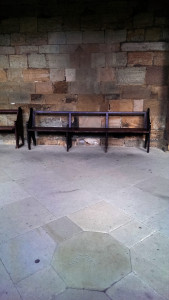
Meridies is the Latin for midday and the arrangement of the hole and the marks on the floor and the wall are designed to measure the time of midday. Margaret Scott Gatty (1809-1873) in “The Book of Sun-Dials” explains:
“A meridian line was drawn in the cloister of Durham Cathedral, partly on a south wall and partly on the pavement, in 1829, by Mr. William Lloyd Wharton, of Dryburn, and Mr. Carr, then Head Master of Durham School. The description of this, written some years ago by the late Rev. Temple Chevallier, will serve for all.
“In the upper part of one of the unglazed windows of the cloister, about 10 feet from the floor, a piece of stone is inserted, in which is a circular aperture, about an inch in diameter, with a thin edge. When the sun is near noon, and thus almost directly opposite to this aperture, the light which streams through the aperture forms a luminous image which, when the sun is high, as near midsummer, falls on the pavement, and when the sun is low, as near the winter solstice, falls upon the opposite wall. By observing the time of the first contact of the circular spot of light with the meridian line, and also the time of the last contact, and taking the mean, I have found that the instant of apparent noon can be ascertained within a second of time.”
When I visited the cathedral in the morning of 2014 Oct 25th and took these photos, it was a pretty cloudy day. But eventually the sun broke through and I was able to capture the luminous image of the Sun on the wall opposite the arched windows. It was below and to the left of the meridian mark because the photo was taken before noon and the Sun was not yet at its lowest point of the year at midday.
Other English Meridian Lines
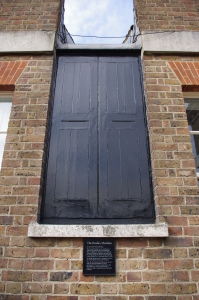
There are a number of well-known meridian lines at the Royal Observatory Greenwich. The most famous is the Prime Meridian at zero degrees longitude, defined in 1851 by the position of George Airy’s Transit Circle Telescope. But there are several other earlier meridian lines nearby: Bradley’s Meridian (c1750), Halley’s Meridian (c1725) and Flamsteed’s Meridian (c1689).
These Greenwich meridians were designed to be used with telescopes, accurately defining the time at which the Sun and other astronomical objects pass through crosshairs in the field of view as the Earth spins.
But I have to admit to having a soft spot for the rather less technological meridian lines like that in Durham, in which sunlight passing through a hole is cast directly onto a north-south line inscribed in a floor or wall. There are several others of these in England.
According to Douglas Bateman in this article (pdf) for the September 2008 Bulletin of the British Sundial Society, the one at Bramshill House in Hampshire is inaccessible to the public because it is now part of the national police training college. It is described in detail by Bateman who suggests that this may be the first British example of such a meridian line, dating from around 1720.
Two other lines are known: at Ramsgate Maritime Museum in the Clock House on the quayside and at Bromley House Library in Nottingham. This latter meridian line consists of a brass strip in the floor of one of the first-floor rooms, now revealed after many years hidden beneath a carpet. One of the window shutters contains the small hole to let through the sunlight, indicating local noon as it passes across the brass strip.
Meridian Lines in Continental Europe
As Margaret Scott Gatty points out, before these meridian lines were constructed in England, they were already popular in continental Europe:
“The most celebrated, and perhaps the earliest, is that of St. Petronio, Bologna, 220 feet in length, and traced by Gian Francesco Cassini in 1653. In 1703 one was laid down on the floor of Santa Maria degli Angeli, Rome. Others may be found in several places on the Continent, as at St. Sulpice in Paris.”
In fact, there were meridian lines which pre-dated that of Cassini’s in Bologna. According to J.L. Heilbron in an article for the Catholic Education Resource Center (adapted from his book The Sun in the Church: Cathedrals as Solar Observatories), sometime soon after 1571, Egnatio Danti was engaged by Cosmo I de’ Medici to construct a meridian line in the Church of Santa Maria Novella in Florence. As Heilbron describes:
“Danti’s plan was to turn the church into a gigantic camera obscura, or pinhole camera, and the hole was to function as its aperture… The surface in Danti’s scheme was the floor of the church, where, in the immense darkened chamber, the bright disk of the sun would project with such detail that observers who knew what to look for would even be able to see sunspots.”
Following the death of Medici, Danti was transferred to Bologna in 1575 and set about creating another great meridian line in the Basilica of St, Petronio. Sadly, for various reasons described by Heilbron, this was a rather crude affair. However, 80 years later in 1655, the great astronomer Cassini succeeded in replacing this with a vastly improved and accurate meridian line in St Petronio which exists to this day.
Unfortunately, I’ve not yet visited the St. Petronio or St. Sulpice meridians (the latter featuring rather notoriously recently in Dan Brown’s Da Vinci Code). However, I have visited two others, in Rome and in Naples.
Santa Maria degli Angeli e dei Martiri, Rome
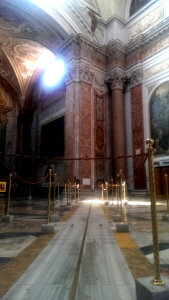
Next time you’re in Rome, make sure you visit the Basilica of St. Mary of the Angels and the Martyrs. Laid diagonally across the floor and protected by guard ropes is a quite beautiful meridian line, 45 metres long, made of bronze and surrounded by marble flooring.
This meridian line was built by Francesco Bianchini and completed in 1702. It had been commissioned by Pope Clement XI, in part to check the calendar but also to compete with Cassini’s Meridian in Bologna.
An excellent technical description of the Rome Meridian is provided in this webpage by Jurgen Giesen, including an applet allowing you to calculate the position of the solar image at any time of the year!
Museo Archeolologico Nazionale de Napoli, Naples
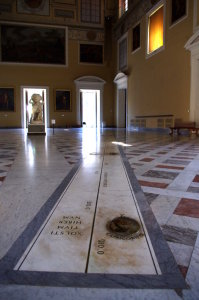
The National Archaeological Museum in Naples is famous for its collections of Roman artefacts from Pompeii and Herculaneum, including the rather racy Secret Museum. However, don’t miss out on a visit to the Gran Salone della Meridiana (Meridian Room).
The Museum’s own website explains its Meridian Line :
“The room underwent transformations between 1790 and 1793, when it was decided to install an Astronomic Observatory in the North-West wing at the suggestion of the astronomer Giuseppe Casella. However, the project was soon abandoned and only the meridian on the floor was built, giving the room its name.
“Designed by Pompeo Schiantarelli and over 27 metres long, it consists of a brass strip arranged between marble panels in which beautiful painted medallions are set depicting the twelve signs of the zodiac. At midday local time, the sunlight enters the hole of the gnomon placed high up in the South-West corner and its rays strike the meridian line of the floor, running along it according to the season.”
Ancient alignments
These meridian lines of the last four hundred years are of course in a long tradition of building structures designed to align with astronomical events, for example:
Stonehenge – see Parker-Pearson’s Researching Stonehenge: Theories Past and Present for a detailed discussion of ways in which Stonehenge (dating back to around 3000 BC) can be linked to celestial events, and also, more recently, the discovery of pits which may align Stonehenge with the midsummer sunrise and sunset;
Newgrange – the Irish passage tomb constructed around 3,200 BC. At dawn on the days around the winter solstice, a shaft of light enters the passageway through a hole above the doorway and illuminates the wall in the central chamber. These days, a lottery is held to select who can be present within the tomb to witness the event.
Chankillo –“The Thirteen Towers of Chankillo run north to south along a low ridge within a fourth-century B.C.E. ceremonial complex in north coastal Peru. From evident observing points within the adjacent buildings to the west and east, they formed an artificial toothed horizon that spanned—almost exactly—the annual rising and setting arcs of the Sun.” – Ghezzi & Ruggles 2007.
Clearly these days we don’t need buildings or meridian lines to measure time – we use atomic clocks and radio telescope observations of quasars. But there is something magical about seeing an alignment or the image of the Sun creeping across the floor towards a meridian. I for one, hope we’ll carry on building them.
Whilst planning construction of your own Stonehenge or Chankillo, you can use this brilliant website by Demeter Sztanko (@sztanko) to check whether you live on a street that is already aligned with sunrise or sunset on the solstices. Ours does. Now if only it weren’t so cloudy in Manchester!

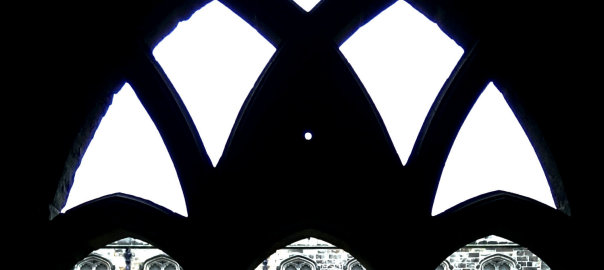
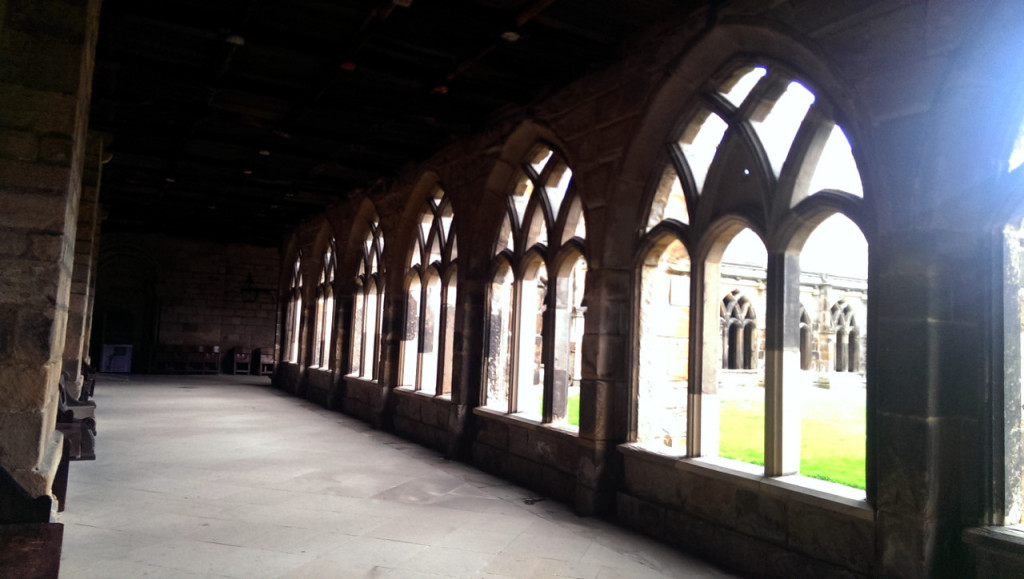
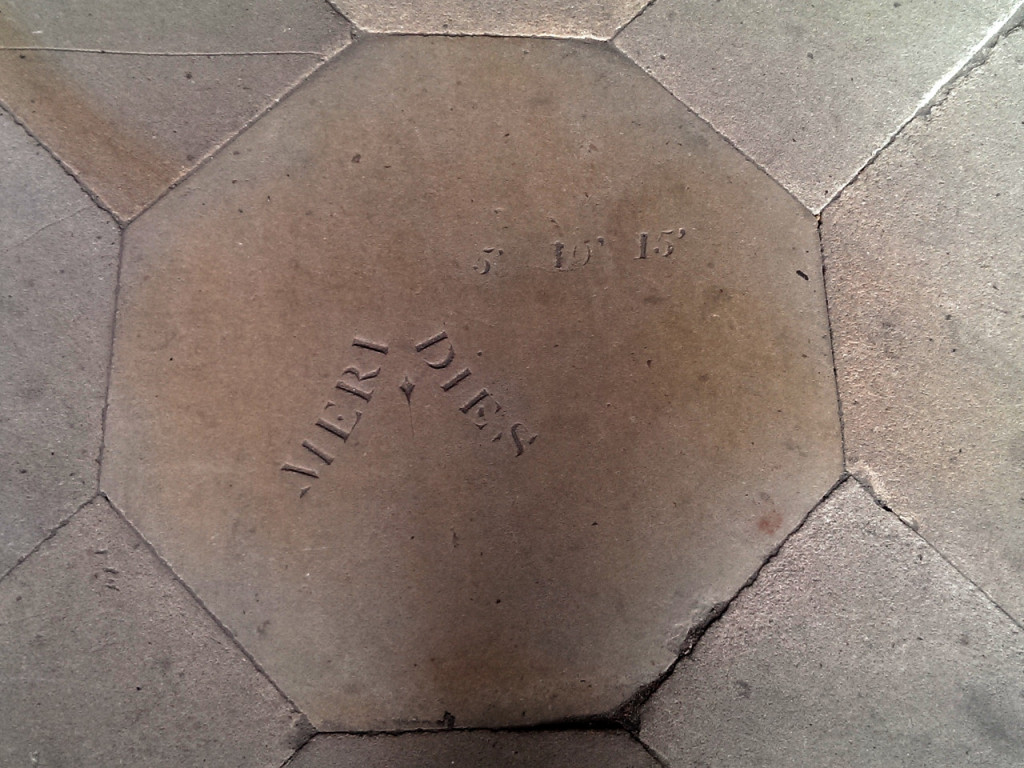
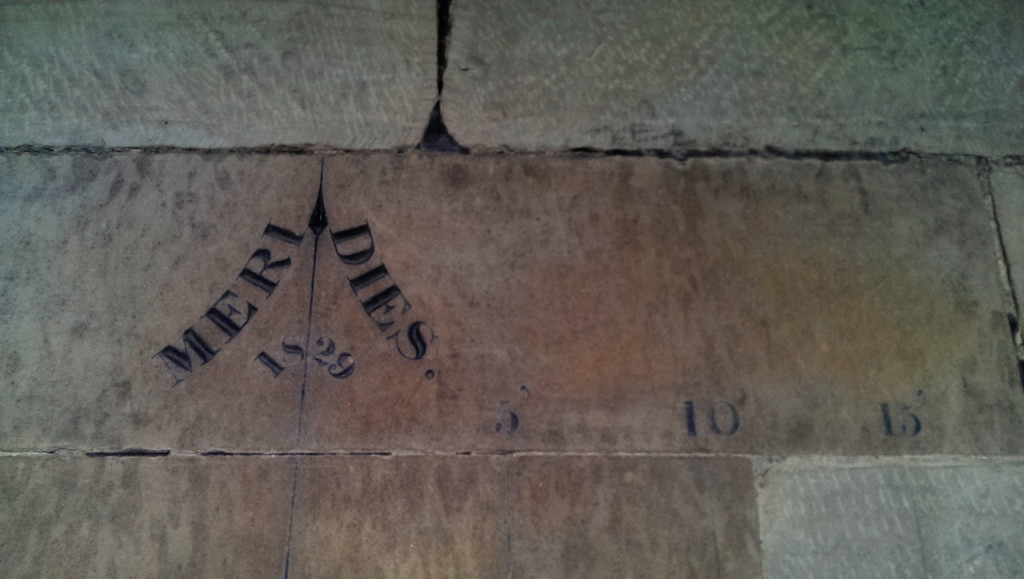
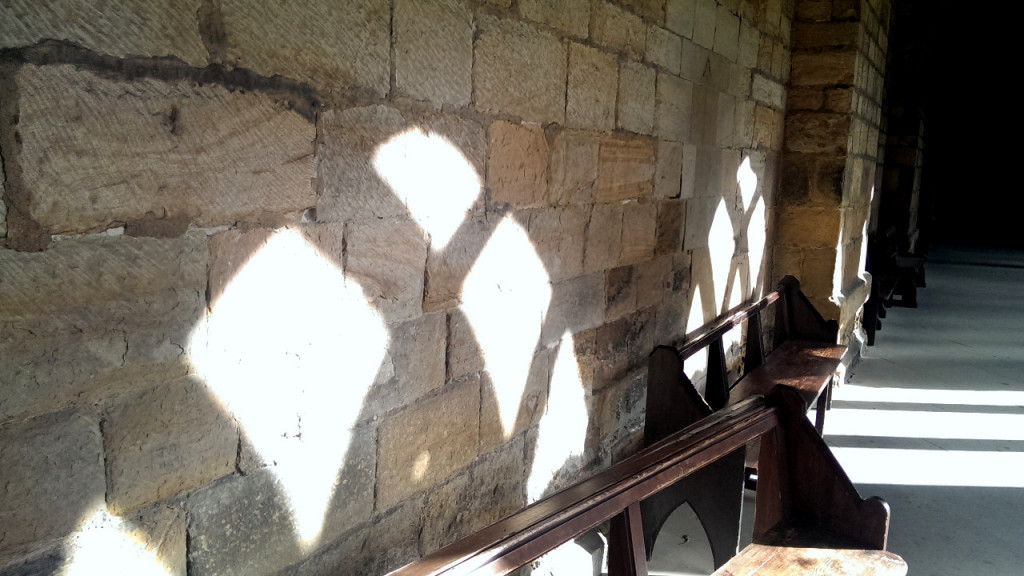
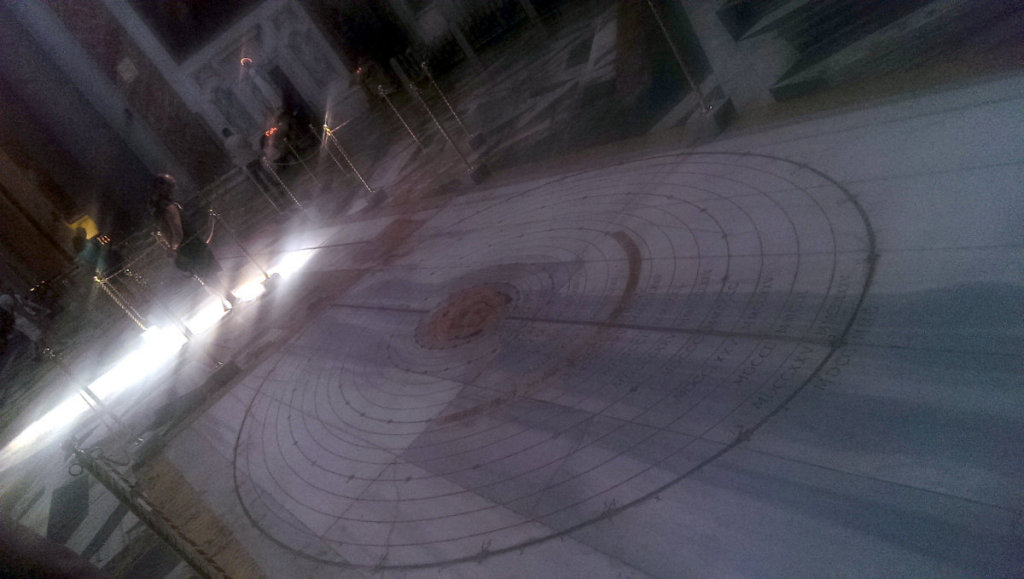
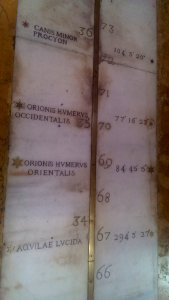
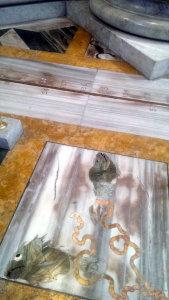
8 responses to “In Praise of Meridian Lines”
I’m sure you’re aware of it, though it doesn’t apear in this article – but Prof J L Heilbron, in his splendid book ‘The Sun in the Church,’ offers a very good discussion of meridian lines and their history right down to the invention of the electric telegraph. He tells (pp284-5) the wonderful story of Belgium’s 47 planned meridians commissioned in 1836 of which several survive, though made almost immediately obsolete, as far as the railways were concerned, by Professor Morse and his invention – first used between Euston and Camden Town in 1837. Best wishes.
Hi Martin, thanks for this! Yes, I was aware of Heilbron’s book – I do comment on it in this article and link to an extract from it. I did order a copy after I found the link I included but haven’t yet read it right through – I must do so, the Belgian story sounds great!
All the best
Tim
You are not the only one who interested in meridians. Even coins and medals exist that hold these equipments. See them here: Meridians, transit equipments
BTW here in Hungary in Eger we have a really beautiful meridian line open for the visitors. All the best,
Tamás
Hi Tamas
can you please tell me where I can find more information about the Meridien in Hungary, where to find it and any other information?
Thank you
Kinchem
I am posting this message from the San Petronio Basilica in Bologna, thank you for a very interesting read! I found this website just through curiousity started by a Wikipedia page on the Basilica and have enjoyed being a little more infrmed on the technicalities and history of the lines here. They are beautiful and despite the charge if you want to take photos (€3!) entrance is free so if anyone is near Bologna it is definitely worth checking out.
Thank you.
Can you offer any explanation for the numbers adjacent to the meridian in Bologna? On one side of the line they count from 1 to over 200, and it is clear that they are units of 1/100 of the height to the gnomon. On the other side the numbers appear to refer to hours and minutes – they count up to 59, then there is a Roman number, then they restart and count again to 59. I cannot work out what the significance of the numbers is though.
Are you aware of any information about a meridian line that might at one time have been in the Seville, Spain, cathedral? I was there and observed a very nice sunshine spot on the floor but did not observe any meridian markings. I wonder if at one time there was a meridian line. In 1888 an earthquake induced collapse caused much damage so possibly at one time a line existed.
I’m not aware of any sorry